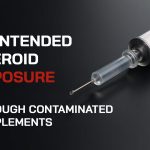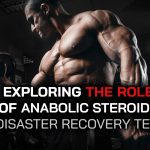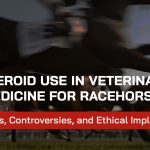Your basket is currently empty!
Category:
How Long Anabolic Steroids Stay in Your System: A Comprehensive Guide
November 16th, 2024 by anabolicpointAnabolic steroids, synthetic derivatives of testosterone, are widely used for both medical and non-medical purposes. Whether prescribed to treat medical conditions or used by athletes and bodybuilders for performance enhancement, one question often arises: How long do anabolic steroids stay in your system?
The answer depends on several factors, including the specific steroid used, the method of administration, dosage, frequency, and individual differences such as metabolism and body composition. Understanding the duration of anabolic steroids in the body is crucial for medical compliance, drug testing in sports, and awareness of potential health risks.
This article explores the pharmacokinetics of anabolic steroids, the factors influencing their presence in the system, detection methods, and implications for users.
The Basics of Anabolic Steroids and Their Metabolism
Anabolic steroids mimic the effects of testosterone in the body, enhancing muscle growth, recovery, and overall physical performance. Once administered, steroids are metabolized in the liver and excreted through urine.
The time it takes for anabolic steroids to leave the system is largely determined by their half-life, which varies significantly between different types of steroids. The half-life is the time required for the concentration of the drug in the bloodstream to reduce by half. Steroids with longer half-lives remain in the system for extended periods, whereas those with shorter half-lives clear more quickly.
Types of Anabolic Steroids and Their Half-Lives
The half-life of anabolic steroids varies depending on their form (oral or injectable) and the type of ester attached to the compound.
- Oral Steroids
Oral steroids, such as Dianabol (methandrostenolone) and Winstrol (stanozolol), generally have shorter half-lives, often ranging from a few hours to a day. They are metabolized quickly but can still be detected for days or weeks after the last dose due to metabolites stored in body tissues. - Injectable Steroids
Injectable steroids, such as testosterone enanthate or nandrolone decanoate, are often attached to long-chain esters, which slow their release into the bloodstream. These steroids can have half-lives ranging from several days to weeks, meaning they stay in the body for much longer periods.
Detection Windows of Common Anabolic Steroids
Detection windows refer to how long after administration a steroid can be identified in the body through drug testing. These windows are influenced by the steroid’s half-life, the testing method, and individual factors like metabolism.
- Dianabol (Methandrostenolone): Detectable for up to 6 weeks.
- Testosterone Enanthate: Detectable for 3–4 months.
- Nandrolone Decanoate (Deca-Durabolin): Detectable for up to 18 months.
- Trenbolone Acetate: Detectable for 4–5 months.
- Winstrol (Stanozolol): Detectable for 2 months.
- Anavar (Oxandrolone): Detectable for 3–4 weeks.
These timeframes can vary based on the sensitivity of the drug test and the user’s physiology.
Factors Influencing Steroid Clearance
The duration anabolic steroids stay in your system depends on several factors, including:
1. Dosage and Frequency
Higher doses and frequent administration lead to accumulation in the body, extending the time needed for complete clearance.
2. Type of Steroid
Long-acting steroids attached to slow-releasing esters take longer to clear than short-acting steroids.
3. Method of Administration
Injectable steroids typically remain in the system longer than oral steroids because of their slower absorption rate.
4. Individual Metabolism
Metabolic rate, age, liver and kidney function, and overall health significantly influence how quickly steroids are processed and excreted.
5. Body Fat Percentage
Anabolic steroids are lipophilic (fat-soluble), meaning they can be stored in fat tissues. Individuals with higher body fat percentages may retain steroids longer.
How Drug Testing Detects Anabolic Steroids
Drug tests detect anabolic steroids by identifying their metabolites, the byproducts of their breakdown in the body. Advanced testing methods, such as gas chromatography-mass spectrometry (GC-MS) and liquid chromatography-tandem mass spectrometry (LC-MS/MS), can identify steroids long after their effects have worn off.
Types of Tests
- Urine Tests: The most common method, effective for detecting steroid metabolites.
- Blood Tests: Provide a shorter detection window, often used for real-time assessments.
- Hair Tests: Can detect steroid use for months, depending on hair length.
Implications of Detection for Athletes and Users
Athletes in competitive sports are subject to stringent anti-doping regulations, with organizations like the World Anti-Doping Agency (WADA) imposing penalties for detected steroid use. Understanding the detection windows is critical for athletes to avoid violations, though abstinence remains the only foolproof solution.
For non-athletes, awareness of steroid clearance times is important for health monitoring, especially if transitioning off steroids to restore natural hormonal balance.
Risks of Prolonged Steroid Presence in the Body
Even after the active effects of steroids have subsided, their lingering metabolites can affect the body. Potential risks include:
- Hormonal Imbalance: Suppression of natural testosterone production may persist, requiring post-cycle therapy (PCT) to restore normal hormone levels.
- Liver Stress: Oral steroids can continue to impact liver function during the clearance period.
- Cardiovascular Strain: Prolonged use increases the risk of long-term cardiovascular issues.
Managing Steroid Clearance
To promote faster clearance of anabolic steroids, users should prioritize hydration, a balanced diet, and regular exercise. However, these measures have limited impact, as steroid metabolism is primarily determined by liver enzymes and genetic factors.
For individuals experiencing adverse effects or complications, medical consultation is essential. Healthcare providers may recommend post-cycle therapy to support recovery and mitigate withdrawal symptoms.
Frequently Asked Questions About Anabolic Steroid Clearance
1. How long do anabolic steroids stay in the body?
The duration depends on the type of steroid, dosage, administration method, and individual factors. Oral steroids clear faster (days to weeks), while injectable steroids can remain for months.
2. What determines the detection window of steroids?
The detection window is influenced by the steroid’s half-life, the sensitivity of the drug test, and individual metabolic factors.
3. Can you speed up the clearance of steroids?
While hydration and a healthy lifestyle may help, the primary determinants of steroid clearance are liver function and metabolic rate.
4. Which steroids stay in the system the longest?
Long-acting injectable steroids, such as nandrolone decanoate, can remain detectable for up to 18 months.
5. Do oral steroids clear faster than injectables?
Yes, oral steroids generally clear faster due to their shorter half-lives and rapid metabolism.
6. How do drug tests detect steroid use?
Drug tests identify steroid metabolites in urine, blood, or hair samples using advanced analytical techniques.
7. Are there health risks while steroids are still in the system?
Yes, lingering metabolites can contribute to hormonal imbalances, liver stress, and cardiovascular issues.
8. Can anabolic steroids be detected after effects have worn off?
Yes, metabolites can be detected long after the anabolic effects have diminished, especially with sensitive testing methods.
9. Why do athletes need to know steroid clearance times?
Understanding clearance times helps athletes comply with anti-doping regulations and avoid potential violations.
10. What is post-cycle therapy (PCT), and why is it needed?
PCT involves medications and supplements to restore natural hormone production and counteract the side effects of steroid use.
A Deeper Understanding of Steroid Metabolism
Understanding how long anabolic steroids stay in your system is essential for making informed decisions, whether for medical purposes, athletic performance, or personal health. With proper awareness of clearance times, risks, and detection methods, users can navigate the complexities of steroid use responsibly. This knowledge not only safeguards individual health but also upholds the integrity of competitive sports and fosters a culture of accountability.
Are Anabolic Steroids Addictive? Understanding Their Impact on Dependency
November 16th, 2024 by anabolicpointAnabolic steroids, known for their performance-enhancing and muscle-building properties, have long been a subject of debate in both athletic and medical communities. While their ability to enhance physical performance is well-documented, an equally significant aspect of their use is the potential for addiction. Understanding whether anabolic steroids are addictive requires a comprehensive exploration of their effects on the body and mind, the psychological dependency they may foster, and the risks associated with prolonged use.
This article delves into the nature of anabolic steroids, their addictive potential, and the broader implications of dependency for users, particularly athletes.
What Are Anabolic Steroids?
Anabolic steroids, or anabolic-androgenic steroids (AAS), are synthetic derivatives of testosterone, the primary male sex hormone. They are used medically to treat conditions such as delayed puberty, muscle loss due to chronic illnesses, and hormonal imbalances. However, their misuse has become prevalent, particularly among athletes and bodybuilders seeking to enhance physical performance, build muscle mass, and improve endurance.
Unlike other recreational drugs, anabolic steroids do not produce the euphoric high associated with substances like opioids or stimulants. Instead, they affect the body’s hormonal balance, altering physical and psychological states.
Are Anabolic Steroids Addictive?
The question of whether anabolic steroids are addictive is complex, as their addictive potential differs from substances such as alcohol or nicotine. Anabolic steroids can lead to both physical dependency and psychological addiction, though the latter is more pronounced.
Psychological Addiction
Anabolic steroids are often associated with psychological dependency rather than traditional chemical addiction. Users may develop a reliance on the perceived benefits of steroids, such as increased muscle mass, enhanced athletic performance, or improved physical appearance. Over time, this reliance can lead to compulsive use despite negative consequences.
Many users experience a psychological craving to maintain their enhanced physique or performance levels, leading to repeated use and difficulty stopping. Withdrawal symptoms, including depression, anxiety, and mood swings, further reinforce the cycle of dependency.
Physical Dependency
While less common than psychological addiction, physical dependency on anabolic steroids can occur. Prolonged use suppresses the body’s natural testosterone production, leading to hormonal imbalances when steroid use is discontinued. This condition, known as hypogonadism, can cause physical and emotional symptoms, such as fatigue, irritability, and loss of libido.
The Mechanisms Behind Steroid Addiction
Dopaminergic System
Anabolic steroids influence the brain’s reward system by interacting with the dopaminergic pathways. Though their effect on dopamine is less direct than substances like cocaine, steroids can still create a cycle of reward and reinforcement that encourages continued use.
Body Dysmorphia and Psychological Factors
Many anabolic steroid users suffer from body dysmorphic disorder, a mental health condition characterized by obsessive concerns about physical appearance. Steroids offer a temporary solution to these insecurities, fostering psychological dependency.
Additionally, the competitive and aesthetic pressures in sports and bodybuilding can exacerbate the psychological pull toward steroid use, further increasing the risk of addiction.
The Risks of Anabolic Steroid Addiction
Steroid addiction carries significant physical, psychological, and social risks. Prolonged misuse can lead to severe health complications, including:
- Cardiovascular Issues: Steroids can cause high blood pressure, increased cholesterol levels, and an elevated risk of heart attack or stroke.
- Liver Damage: Oral anabolic steroids are particularly taxing on the liver, potentially causing liver failure.
- Hormonal Imbalances: Long-term use suppresses natural testosterone production, leading to infertility, gynecomastia (breast development in men), and other hormonal disorders.
- Psychiatric Effects: Steroid use is linked to aggression, mood swings, and a condition colloquially known as “roid rage.”
- Withdrawal Symptoms: Discontinuing steroid use can lead to depression, anxiety, and severe fatigue, making it difficult for users to quit.
Socially, steroid addiction can isolate individuals from friends and family, especially as their behavior becomes more erratic and their focus narrows to maintaining their physique or performance.
Recognizing the Signs of Steroid Addiction
Identifying steroid addiction involves recognizing both behavioral and physical symptoms. Common indicators include:
- Compulsive use of steroids despite adverse effects.
- Spending excessive time and money obtaining or using steroids.
- Prioritizing steroid use over personal and professional responsibilities.
- Exhibiting mood swings, aggression, or irritability.
- Experiencing withdrawal symptoms when attempting to stop.
For many users, denial is a significant barrier to acknowledging addiction, making external intervention necessary in severe cases.
Treating Steroid Addiction
Medical Intervention
Treatment for steroid addiction often begins with addressing the physical consequences of prolonged use. Medical professionals may prescribe hormone replacement therapy to restore natural testosterone levels or medications to manage withdrawal symptoms.
Counseling and Behavioral Therapy
Psychological support is crucial for overcoming steroid addiction. Cognitive-behavioral therapy (CBT) helps users identify and change harmful thought patterns, while group therapy provides a supportive environment for shared experiences and encouragement.
Holistic Approaches
For long-term recovery, a holistic approach that includes physical rehabilitation, nutritional counseling, and mental health support is essential. Rebuilding a healthy lifestyle without reliance on steroids is a key component of successful treatment.
The Legal and Ethical Implications of Steroid Addiction
The use of anabolic steroids without a prescription is illegal in many countries, and their possession or distribution can lead to severe legal consequences. In competitive sports, the use of banned substances, including steroids, violates ethical standards and can result in disqualification, fines, and tarnished reputations.
Athletes caught using steroids face not only personal consequences but also the loss of trust from their fans and the public. The stigma associated with doping further complicates the recovery process for those struggling with addiction.
Addressing Steroid Addiction in Society
Raising awareness about the risks of anabolic steroid use and addiction is crucial for prevention. Educational programs targeting young athletes, bodybuilders, and fitness enthusiasts can help dispel myths about steroids and promote healthier alternatives for achieving physical goals.
Anti-doping organizations and sports authorities play a vital role in deterring steroid use by implementing rigorous testing protocols and enforcing strict penalties for violations.
Frequently Asked Questions About Anabolic Steroid Addiction
1. Are anabolic steroids physically addictive?
While physical dependency is less common, anabolic steroids can disrupt natural testosterone production, leading to withdrawal symptoms and a reliance on external hormones.
2. What are the signs of steroid addiction?
Signs include compulsive use, mood swings, withdrawal symptoms, and prioritizing steroids over other responsibilities.
3. Can you quit steroids cold turkey?
Suddenly stopping steroids can lead to severe withdrawal symptoms. Gradual tapering under medical supervision is recommended.
4. Are there alternatives to steroids for building muscle?
Yes, alternatives include proper nutrition, resistance training, and legal supplements like protein powders and creatine.
5. What is body dysmorphic disorder, and how does it relate to steroid addiction?
Body dysmorphic disorder is a mental health condition where individuals obsess over perceived flaws in their appearance. Steroids are often used as a coping mechanism.
6. What is “roid rage”?
“Roid rage” refers to aggressive and erratic behavior linked to steroid use, caused by hormonal imbalances.
7. Is it illegal to use anabolic steroids?
In many countries, using anabolic steroids without a prescription is illegal and carries legal consequences.
8. How long does it take to recover from steroid addiction?
Recovery time varies depending on the duration and intensity of use, but a comprehensive treatment plan can accelerate the process.
9. Do steroids cause permanent damage?
Prolonged use can lead to irreversible effects, such as liver damage, heart issues, and hormonal imbalances.
10. Can therapy help with steroid addiction?
Yes, therapy is a critical component of recovery, addressing both the psychological and behavioral aspects of addiction.
Toward a Healthier Path
Understanding the addictive potential of anabolic steroids underscores the need for informed decision-making and responsible behavior. While steroids may offer short-term physical benefits, the long-term consequences, including addiction, far outweigh these gains.
By fostering awareness and promoting healthier alternatives, society can help individuals achieve their fitness goals without compromising their health or well-being. For those grappling with addiction, support and treatment offer a pathway to recovery and a chance to rebuild their lives free from dependency.
The Stigma Around Anabolic Steroids: Misconceptions, Realities, and Social Impact
November 16th, 2024 by anabolicpointAnabolic steroids, or anabolic-androgenic steroids (AAS), are one of the most controversial substances in the world of fitness, sports, and medicine. While they have legitimate therapeutic uses, the misuse of these substances for performance enhancement or aesthetic purposes has led to widespread condemnation and stigmatization. The stigma surrounding anabolic steroids often stems from a combination of misinformation, moral judgment, and the actions of individuals who misuse these substances without regard for the consequences.
This article delves into the stigma around anabolic steroids, exploring its origins, impact, and the broader societal perceptions. We will also examine the myths and realities surrounding anabolic steroids to provide a balanced perspective on this complex issue.
Understanding Anabolic Steroids
Anabolic steroids are synthetic derivatives of testosterone, the hormone responsible for the development of male secondary sexual characteristics and the regulation of muscle mass, strength, and recovery. These compounds have two primary effects:
- Anabolic Effects: Promoting muscle growth, increasing bone density, and enhancing recovery.
- Androgenic Effects: Developing male characteristics like facial hair, a deeper voice, and increased aggression.
In medicine, anabolic steroids are prescribed to treat conditions like delayed puberty, muscle-wasting diseases, and hormonal imbalances. However, their misuse—often involving high doses and unregulated use—has fueled the negative reputation they carry today.
Origins of the Stigma
The stigma around anabolic steroids can be traced to several interconnected factors:
1. Misuse in Sports and Fitness
The misuse of anabolic steroids for performance enhancement and bodybuilding has been widely publicized, especially through high-profile doping scandals. Athletes who use steroids are often viewed as cheaters, undermining the principles of fair competition and hard work. This association has painted all steroid users with a broad brush of condemnation, regardless of the context in which they use the substance.
2. Media Sensationalism
Sensationalized media reports often portray anabolic steroids as dangerous drugs used by reckless individuals seeking superficial gains. Stories of “roid rage” and catastrophic health consequences dominate the narrative, reinforcing negative stereotypes and fostering fear.
3. Legal and Regulatory Actions
In many countries, anabolic steroids are classified as controlled substances. This legal status equates their use with criminal behavior, further perpetuating the stigma. Athletes caught using steroids face bans, fines, and public disgrace, reinforcing the perception that steroids are inherently harmful and unethical.
4. Moral and Ethical Judgments
The use of anabolic steroids is often seen as a shortcut that undermines the values of hard work, discipline, and natural ability. This moralistic perspective disregards the complexities of why individuals turn to steroids, lumping all users into a single category of unethical behavior.
Myths vs. Realities
Myth 1: All Steroid Users Are Athletes or Bodybuilders
While athletes and bodybuilders are the most visible users, anabolic steroids are also used in medical contexts and by individuals recovering from injuries or illnesses. Non-athletes seeking aesthetic improvements or dealing with body dysmorphia may also use steroids.
Myth 2: Steroids Guarantee Instant Results
Steroids do enhance muscle growth and recovery, but their effects depend on rigorous training, proper nutrition, and genetics. They are not a magic solution but a tool that amplifies existing efforts.
Myth 3: All Steroid Use Is Dangerous
When used under medical supervision, anabolic steroids can be safe and effective. The dangers arise primarily from misuse, including high doses, prolonged cycles, and unregulated products.
Myth 4: Steroid Users Are Aggressive and Violent
The concept of “roid rage” is often exaggerated. While steroids can influence mood, not all users experience aggression, and individual temperament plays a significant role.
The Impact of Stigma
The stigma surrounding anabolic steroids has far-reaching implications for individuals, healthcare systems, and society at large.
1. Impact on Users
Stigmatized individuals often feel judged and ostracized, which can lead to social isolation and reluctance to seek medical advice. This lack of open dialogue increases the risks of misuse, as individuals may rely on unverified information and unsafe practices.
2. Impact on Healthcare
The stigma deters users from consulting healthcare professionals, leaving them vulnerable to complications from unsupervised steroid use. Physicians, in turn, may be hesitant to engage with patients due to societal biases or lack of specialized training.
3. Perpetuation of Misinformation
The negative stereotypes and myths surrounding steroids overshadow scientific discourse, making it difficult for the public to differentiate between legitimate use, misuse, and abuse. This perpetuates a cycle of fear and misunderstanding.
Challenging the Stigma
Addressing the stigma around anabolic steroids requires a balanced approach that acknowledges both the risks and legitimate uses of these substances.
1. Education and Awareness
Public education campaigns should focus on evidence-based information about anabolic steroids, emphasizing the difference between medical use and misuse. Educating young athletes and fitness enthusiasts about the risks and alternatives can prevent misuse.
2. Encouraging Open Dialogue
Creating safe spaces for discussion can reduce stigma and encourage individuals to seek help or advice. Healthcare providers, trainers, and educators play a crucial role in fostering these conversations.
3. Promoting Harm Reduction
Harm reduction strategies, such as providing access to clean needles, accurate dosing information, and mental health support, can mitigate the risks associated with steroid misuse.
4. Reforming Policies
Policy reforms that distinguish between medical use and recreational misuse can help reduce the criminalization of anabolic steroids. This distinction would encourage users to seek legitimate medical advice without fear of legal repercussions.
Societal Shifts in Perception
Over time, societal attitudes toward anabolic steroids may evolve, much like perceptions of other substances have changed. By reframing the conversation around steroids to include empathy, education, and evidence-based policies, it is possible to dismantle the stigma and promote responsible use.
Frequently Asked Questions About Anabolic Steroid Stigma
1. Why are anabolic steroids so stigmatized?
Anabolic steroids are stigmatized due to their association with cheating in sports, health risks from misuse, and negative media portrayals.
2. Are all steroid users misusing the substance?
No, many individuals use anabolic steroids for legitimate medical purposes under professional supervision. Misuse often involves non-medical, high-dose use for performance enhancement.
3. Does using steroids always lead to aggression?
Not all users experience aggression. The phenomenon of “roid rage” is rare and often exaggerated in media reports.
4. Can the stigma around steroids harm users?
Yes, stigma can lead to social isolation, discourage individuals from seeking medical advice, and perpetuate unsafe practices.
5. How can we reduce steroid stigma?
Reducing stigma involves education, promoting harm reduction, encouraging open dialogue, and reforming policies to distinguish between medical use and misuse.
6. Are anabolic steroids illegal?
In many countries, anabolic steroids are controlled substances, requiring a prescription for legal use. Recreational or unsupervised use is typically illegal.
7. Are the health risks of steroids always severe?
Health risks depend on the dose, duration, and context of use. Medical use is generally safe, while misuse poses significant dangers.
8. Do all athletes use anabolic steroids?
No, many athletes compete successfully without steroids. The use of performance-enhancing drugs is not universal.
9. Can anabolic steroids be used responsibly?
Yes, when prescribed and monitored by a healthcare provider, anabolic steroids can be used responsibly for medical purposes.
10. What role do healthcare providers play in reducing stigma?
Healthcare providers can reduce stigma by offering nonjudgmental care, educating patients, and advocating for harm reduction strategies.
A New Perspective on Steroids
The stigma around anabolic steroids is deeply rooted in societal perceptions of health, ethics, and competition. While the risks of misuse are undeniable, the narrative surrounding these substances often lacks nuance, overshadowing their legitimate applications and the complex motivations behind their use.
By fostering informed dialogue and challenging stereotypes, society can move toward a more balanced understanding of anabolic steroids. This shift will not only benefit individuals but also contribute to a healthier, more empathetic discourse about performance, health, and human potential.
Detecting Anabolic Steroids in Athletes: Methods and Challenges
November 16th, 2024 by anabolicpointThe use of anabolic steroids in sports has been a persistent issue, casting a shadow over the integrity of competitive athletics. These synthetic derivatives of testosterone are used by some athletes to gain an edge in performance, but their misuse violates the principles of fair play and poses significant health risks. As a result, detecting anabolic steroids has become a critical component of anti-doping efforts globally. This article explores the science of steroid detection, the methods employed, challenges faced, and the evolving landscape of drug testing in sports.
The Importance of Detecting Anabolic Steroids
The detection of anabolic steroids serves multiple purposes in sports. It ensures fair competition, protects athletes from the harmful effects of these substances, and upholds the credibility of athletic organizations. Athletes who use steroids gain an unfair advantage in muscle growth, strength, and recovery, undermining the spirit of equality. Moreover, long-term steroid abuse can lead to severe health issues, including liver damage, heart disease, and hormonal imbalances.
To combat this, organizations like the World Anti-Doping Agency (WADA) and the International Olympic Committee (IOC) have implemented stringent drug testing protocols.
How Anabolic Steroids Are Detected
1. Urine Testing: The Gold Standard
Urine testing is the most commonly used method for detecting anabolic steroids. This approach identifies metabolites, the byproducts of steroid metabolism, which remain in the body for extended periods.
The process involves:
- Sample Collection: Athletes provide urine samples under strict supervision to prevent tampering.
- Gas Chromatography-Mass Spectrometry (GC-MS): This advanced analytical technique identifies and quantifies steroid metabolites, providing precise results.
- Isotope Ratio Mass Spectrometry (IRMS): IRMS detects synthetic testosterone by analyzing carbon isotope ratios, differentiating it from natural testosterone.
2. Blood Testing
Blood testing is another effective method, especially for detecting substances with short detection windows or those that influence red blood cell production, such as erythropoietin (EPO). Blood samples can reveal direct steroid use or detect biomarkers indicating steroid effects.
3. Hair Analysis
Though less common, hair analysis can provide a long-term record of steroid use. Substances and their metabolites integrate into hair strands as they grow, offering a timeline of drug intake.
4. Biological Passport
The Athlete Biological Passport (ABP) is a personalized record of an athlete’s biological markers over time. Instead of detecting specific substances, the ABP monitors changes in parameters like testosterone-to-epitestosterone (T/E) ratios, red blood cell count, and hormone levels, which can indicate doping.
Common Challenges in Detecting Anabolic Steroids
Evolving Steroid Compounds
Athletes and illicit manufacturers continually develop new steroids to evade detection. These designer steroids are chemically modified to bypass standard testing protocols, requiring constant updates to detection methods.
Short Detection Windows
Some anabolic steroids are quickly metabolized and excreted, leaving a narrow window for detection. Advanced techniques, such as identifying long-lasting metabolites, are essential for addressing this challenge.
Masking Agents
Athletes may use masking agents to interfere with drug tests. These substances either hide the presence of steroids or dilute the sample to make detection more difficult.
Variability in Individual Metabolism
Differences in how individuals metabolize steroids can complicate detection. Factors such as genetics, age, and health conditions influence the duration substances remain detectable.
The Role of Anti-Doping Organizations
Global anti-doping efforts are spearheaded by organizations like WADA, which sets standards for drug testing and enforces regulations. These efforts include:
- Education and Prevention: Informing athletes about the risks and consequences of doping.
- Random Testing: Conducting unannounced tests during training and competitions.
- Research and Development: Innovating new detection techniques to stay ahead of emerging doping methods.
Anti-doping agencies collaborate with laboratories worldwide to maintain a robust testing framework, ensuring credibility and fairness in sports.
Ethical and Legal Aspects of Steroid Detection
The pursuit of steroid-free sports raises ethical and legal questions. While rigorous testing is essential, it must be balanced with athletes’ rights to privacy and fair treatment. False positives, procedural errors, or inconsistent regulations can damage careers and reputations.
Athletes accused of doping are entitled to due process, including the right to appeal and independent verification of test results. Striking this balance between rigorous enforcement and fairness remains a cornerstone of effective anti-doping programs.
Advancements in Detection Technology
Recent innovations are transforming the landscape of steroid detection:
- Enhanced Sensitivity: Modern analytical tools can detect substances at minute concentrations, increasing the likelihood of catching violators.
- Gene Doping Detection: As gene editing technologies emerge, new methods are being developed to identify genetic modifications used for performance enhancement.
- AI and Big Data: Artificial intelligence is being leveraged to analyze patterns in biological data, improving the accuracy of the Athlete Biological Passport.
These advancements not only enhance detection capabilities but also act as deterrents against doping.
Impact of Steroid Detection on Sports
The detection of anabolic steroids has significantly influenced sports culture. High-profile cases of doping scandals have raised awareness and led to stricter regulations. While the fight against doping is ongoing, progress is evident. Fewer athletes are willing to risk their careers, reputations, and health by using banned substances.
However, the impact goes beyond individual athletes. Enhanced detection reinforces public trust in sports, ensuring that achievements are attributed to talent, effort, and determination rather than artificial enhancements.
Frequently Asked Questions About Steroid Detection
1. How are anabolic steroids detected in athletes?
Anabolic steroids are primarily detected through urine and blood tests using advanced techniques like gas chromatography-mass spectrometry and isotope ratio mass spectrometry.
2. What is the detection window for anabolic steroids?
Detection windows vary depending on the substance, dosage, and individual metabolism. Some steroids are detectable for days, while others leave traces for weeks or months.
3. Can athletes avoid detection?
While some attempt to evade detection using masking agents or designer steroids, advancements in testing methods make it increasingly difficult.
4. What happens if an athlete tests positive for steroids?
Athletes face penalties such as disqualification, suspension, or lifetime bans. Their results may also be annulled, and reputations tarnished.
5. What is the Athlete Biological Passport (ABP)?
The ABP tracks an athlete’s biological markers over time, identifying changes that may indicate doping rather than detecting specific substances.
6. Can natural supplements cause a positive test?
Some supplements may be contaminated with banned substances. Athletes should only use products certified by reputable testing agencies.
7. Are all anabolic steroids banned in sports?
Yes, the use of anabolic steroids without medical justification is prohibited in professional sports under WADA regulations.
8. How do anti-doping organizations ensure fairness?
Organizations follow strict protocols, including random testing, secure sample handling, and independent laboratory analysis to ensure accuracy and fairness.
9. Can genetic testing help in detecting steroids?
Emerging techniques analyze genetic modifications and the body’s response to doping, paving the way for gene-doping detection.
10. Why is steroid detection critical for sports?
Detection upholds the principles of fair play, protects athletes’ health, and ensures the integrity of competitions.
Looking Ahead: The Future of Anti-Doping Efforts
The battle against anabolic steroids in sports is an evolving challenge. As detection technologies advance, athletes and illicit manufacturers adapt, creating a continuous cycle of innovation and countermeasures. The future of anti-doping efforts will likely involve greater collaboration among scientific, legal, and athletic communities.
The ultimate goal is not only to catch violators but also to foster a culture of clean competition, where athletes rely on their natural abilities and hard work. By prioritizing integrity and fairness, the sporting world can ensure that achievements remain a true testament to human potential.
Dangers of Anabolic Steroid Misuse in Sports: Health Risks, Ethics, and Long-Term Consequences
November 16th, 2024 by anabolicpointAnabolic steroids, synthetic derivatives of testosterone, have become synonymous with performance enhancement in sports. Their ability to accelerate muscle growth, improve recovery, and enhance strength has made them appealing to athletes seeking a competitive edge. However, the misuse of anabolic steroids comes with significant dangers, affecting both the physical and mental health of users, as well as the integrity of sports itself.
This article explores the multifaceted dangers of anabolic steroid misuse in sports, detailing the health risks, societal implications, and ethical concerns. By addressing these issues, we aim to provide a comprehensive understanding of why steroid misuse poses a threat to athletes and sports culture alike.
Understanding Anabolic Steroids
Anabolic steroids, also known as anabolic-androgenic steroids (AAS), are designed to mimic the anabolic effects of testosterone, such as muscle building and tissue repair. While they have legitimate medical uses, including the treatment of delayed puberty and muscle-wasting conditions, their non-medical use in sports has been widely criticized.
When used under medical supervision, anabolic steroids can be safe and effective. However, when misused to enhance performance, they often involve high doses and prolonged use, leading to a range of adverse effects.
Why Athletes Misuse Anabolic Steroids
Athletes misuse anabolic steroids to achieve specific performance-related goals:
- Enhanced Muscle Mass and Strength: Steroids increase protein synthesis, leading to faster muscle growth and improved strength.
- Improved Recovery: They help reduce recovery time between workouts, enabling athletes to train more frequently and intensely.
- Increased Stamina and Endurance: Steroids improve oxygen delivery to muscles, boosting endurance.
The pressure to perform at an elite level, coupled with the allure of fame and financial rewards, often drives athletes to risk their health by misusing these substances.
Health Risks of Anabolic Steroid Misuse
Misusing anabolic steroids exposes athletes to a variety of short-term and long-term health risks. These dangers are often compounded by the unregulated nature of steroid acquisition and use.
1. Cardiovascular Complications
Steroid misuse is linked to high blood pressure, increased cholesterol levels, and a heightened risk of heart attack and stroke. Prolonged use can damage the heart muscle, leading to life-threatening conditions.
2. Liver Damage
Oral anabolic steroids are particularly taxing on the liver. They can lead to liver tumors, cysts, and conditions such as peliosis hepatis, where blood-filled cysts develop in the liver.
3. Hormonal Imbalances
Excessive steroid use disrupts the body’s natural hormone production. For men, this can result in testicular shrinkage, reduced sperm production, and gynecomastia (development of breast tissue). For women, it may cause masculinization, including a deeper voice, excessive body hair, and menstrual irregularities.
4. Psychological Effects
Steroid misuse is associated with mood swings, aggression, and irritability, often referred to as “roid rage.” Long-term use can also lead to depression, anxiety, and dependency, affecting an athlete’s mental health and quality of life.
5. Musculoskeletal Issues
While steroids accelerate muscle growth, they do not strengthen tendons and ligaments proportionally. This imbalance increases the risk of injuries, such as tendon ruptures, during intense physical activity.
6. Reproductive Health Problems
Both men and women may experience infertility as a result of steroid misuse. In men, prolonged use can suppress testosterone production, while in women, menstrual cycles may cease entirely.
7. Risk of Infections
Athletes who use injectable steroids risk infections at the injection site and exposure to bloodborne pathogens like HIV and hepatitis if needles are shared or not sterile.
Ethical Implications of Steroid Misuse in Sports
Beyond the personal health risks, steroid misuse has broader implications for the ethics and integrity of sports.
1. Undermining Fair Play
The use of anabolic steroids creates an uneven playing field, giving users an unfair advantage over competitors who follow the rules. This undermines the spirit of fair competition and diminishes the value of hard work and natural talent.
2. Erosion of Trust
Steroid scandals tarnish the reputation of athletes and sports organizations. Fans and sponsors may lose faith in the authenticity of performances, leading to a decline in viewership and support.
3. Pressure on Non-Users
When steroid use becomes widespread, it creates an environment where athletes may feel pressured to use them to remain competitive. This fosters a culture of acceptance around doping, further perpetuating the problem.
Long-Term Consequences of Steroid Misuse
The consequences of anabolic steroid misuse often extend far beyond an athlete’s career, affecting their physical and mental well-being for years.
- Chronic Health Conditions: Cardiovascular and liver damage, as well as hormonal disruptions, may persist long after steroid use has ceased.
- Psychological Dependency: Many athletes struggle with body image issues or the fear of losing their competitive edge, leading to continued misuse.
- Legal and Professional Repercussions: Athletes caught using steroids face suspensions, fines, and damaged reputations, which can limit their future opportunities.
Combating Steroid Misuse in Sports
Addressing the issue of anabolic steroid misuse requires a multifaceted approach involving education, regulation, and enforcement.
1. Education and Awareness
Athletes, coaches, and medical professionals must be educated about the risks of steroid misuse and the importance of ethical competition. Providing young athletes with accurate information can discourage them from using PEDs.
2. Stricter Testing and Penalties
Anti-doping agencies play a critical role in deterring steroid misuse by conducting random tests and imposing penalties on offenders. High-profile cases serve as a warning to others about the consequences of doping.
3. Support for Athletes
Providing support systems for athletes, including counseling and medical guidance, can help address the pressures that lead to steroid misuse. Encouraging a culture that values health and integrity over victory is essential.
Frequently Asked Questions About Anabolic Steroid Misuse in Sports
1. What are anabolic steroids, and why do athletes misuse them?
Anabolic steroids are synthetic hormones that mimic testosterone to enhance muscle growth and performance. Athletes misuse them to gain a competitive edge in strength, endurance, and recovery.
2. What are the health risks of steroid misuse?
Health risks include cardiovascular complications, liver damage, hormonal imbalances, psychological effects, and increased risk of infections.
3. Why is steroid misuse considered unethical in sports?
Steroid misuse violates the principles of fair play, undermines trust in competition, and pressures other athletes to use PEDs to remain competitive.
4. Can the effects of steroid misuse be reversed?
Some effects, such as hormonal imbalances, may be reversible with medical intervention, but others, like cardiovascular and liver damage, can be permanent.
5. How do anti-doping agencies detect steroid misuse?
Agencies use urine and blood tests to identify banned substances. Advanced techniques can detect steroids long after use.
6. What are the legal consequences of steroid misuse?
In many countries, possessing or using anabolic steroids without a prescription is illegal, resulting in fines, suspensions, or imprisonment.
7. Do all athletes misuse steroids?
No, many athletes achieve success through natural talent, training, and ethical competition. Steroid misuse is not universal.
8. What role do coaches play in preventing steroid misuse?
Coaches are critical in promoting ethical values, educating athletes about risks, and creating a supportive environment that discourages doping.
9. Are there safer alternatives to steroids?
Yes, natural methods like proper training, nutrition, and legal supplements can help athletes improve performance safely.
10. How can sports organizations address steroid misuse?
Organizations can invest in education, enforce strict anti-doping policies, and support athletes with resources to cope with competitive pressures.
Preserving the Integrity of Sports
Anabolic steroid misuse in sports threatens not only the health of athletes but also the integrity of competition. Addressing this issue requires a collective effort from athletes, coaches, sports organizations, and fans to promote fair play and ethical values. By fostering a culture that prioritizes health, honesty, and respect, the sporting community can ensure that competition remains a true celebration of human potential.
Benefits of Anabolic Steroids for Athletes in Sports
November 16th, 2024 by anabolicpointAnabolic steroids have been a subject of significant debate within the sporting community for decades. While much attention is often given to their risks and controversies, it is important to understand why athletes may turn to these substances. Known for their ability to enhance physical performance and alter the body’s ability to build muscle, anabolic steroids provide benefits that appeal to those striving for competitive excellence. This article delves into the key advantages of anabolic steroids for athletes in sports, examining how they work, their impact on performance, and the factors that influence their use.
The Science Behind Anabolic Steroids
Anabolic steroids, also known as anabolic-androgenic steroids (AAS), are synthetic substances derived from testosterone. Testosterone, the primary male sex hormone, plays a critical role in promoting muscle growth, strength, and recovery. Anabolic steroids amplify these effects, making them attractive to athletes.
When introduced into the body, anabolic steroids bind to androgen receptors in muscle cells. This interaction increases protein synthesis, the process by which cells generate new proteins, crucial for muscle repair and growth. The result is faster recovery, increased lean muscle mass, and enhanced physical capabilities.
Key Benefits of Anabolic Steroids for Athletes
Enhanced Muscle Growth
One of the primary reasons athletes use anabolic steroids is their ability to accelerate muscle growth. By boosting protein synthesis, steroids help the body build muscle more quickly than it could naturally. This is particularly appealing in sports like bodybuilding, weightlifting, and rugby, where muscle mass is closely tied to performance.
Improved Strength and Power
In addition to promoting muscle growth, anabolic steroids enhance the strength of muscle fibers. This leads to significant increases in overall power and athletic performance, enabling athletes to lift heavier weights, run faster, or perform more explosively during competitions.
Faster Recovery Times
Athletes often face grueling training schedules that can lead to muscle soreness, fatigue, and even injuries. Anabolic steroids reduce muscle damage and inflammation, allowing for faster recovery between sessions. This benefit enables athletes to train more frequently and at higher intensities, giving them a competitive edge.
Increased Endurance
Certain anabolic steroids stimulate the production of red blood cells, which carry oxygen to muscles. Improved oxygenation enhances endurance, allowing athletes to sustain high levels of performance over extended periods. This is particularly advantageous in endurance-based sports such as cycling, marathon running, and swimming.
Fat Loss and Improved Physique
While primarily known for their muscle-building properties, anabolic steroids also aid in fat loss. They boost metabolism and promote the preservation of lean muscle mass during calorie deficits. For athletes, this results in a more defined and powerful physique, which can provide both aesthetic and functional advantages.
Why Athletes Turn to Anabolic Steroids
Athletes often face immense pressure to perform at the highest level, meet demanding physical standards, and achieve results. These pressures, combined with the competitive nature of sports, lead many to consider anabolic steroids as a means to gain an edge. The following factors frequently drive their use:
- Performance Expectations: Athletes are expected to consistently push boundaries, making enhanced strength and endurance critical.
- Recovery Demands: The need to recover quickly from injuries or intense training sessions is a major factor.
- Body Composition Goals: Many sports value athletes who are lean, muscular, and agile. Steroids help in achieving these goals more effectively.
- Competition Pressure: In professional sports, where even marginal gains can make the difference between winning and losing, the allure of performance enhancement can be strong.
The Context of Anabolic Steroids in Different Sports
The use of anabolic steroids is not uniform across all athletic disciplines. Their benefits are most evident in sports that require strength, power, or endurance:
- Bodybuilding and Weightlifting: Here, steroids are used for their unparalleled ability to increase muscle size and strength.
- Track and Field Events: Sprinters and throwers benefit from the explosive power provided by anabolic steroids.
- Endurance Sports: Cyclists and long-distance runners use steroids to improve stamina and reduce fatigue.
- Combat Sports: Fighters and wrestlers often rely on steroids to increase strength and maintain a lean, agile physique.
The Complex Relationship Between Anabolic Steroids and Ethics
While the benefits of anabolic steroids for athletes are undeniable, their use is fraught with ethical and regulatory challenges. Most professional sports organizations, including the International Olympic Committee (IOC) and the World Anti-Doping Agency (WADA), prohibit the use of anabolic steroids. Athletes caught using these substances face penalties, including disqualification, fines, and damage to their reputation.
The ethical debate centers around the concept of fair play. Critics argue that steroids provide an unfair advantage, undermining the integrity of competition. Proponents, however, suggest that they level the playing field, especially in sports where some athletes may have natural physiological advantages.
Controlled and Therapeutic Use of Anabolic Steroids
While their use in competitive sports is often criticized, anabolic steroids have legitimate medical applications. When prescribed by a healthcare professional, they can effectively treat:
- Muscle Wasting Conditions: Diseases like cancer and AIDS often lead to muscle loss, which steroids can counteract.
- Delayed Puberty: Steroids help stimulate the hormonal changes necessary for puberty in certain cases.
- Severe Injuries: For athletes recovering from traumatic injuries, steroids can accelerate the healing process.
The Psychological Aspect of Steroid Use
Beyond physical benefits, anabolic steroids can impact an athlete’s mindset. Increased testosterone levels are linked to heightened aggression and competitiveness, traits that can be advantageous in sports. Additionally, the rapid physical transformations brought about by steroids can boost confidence and motivation.
However, these psychological effects can also lead to negative outcomes, such as mood swings, irritability, and overconfidence.
Dispelling Common Myths About Anabolic Steroids
Steroids Are a Shortcut to Success
Contrary to popular belief, steroids do not replace the need for hard work and dedication. Athletes must still adhere to rigorous training and nutritional programs to maximize their benefits.
Steroids Work the Same for Everyone
Individual factors such as genetics, training intensity, and dosage determine how effectively steroids enhance performance.
Legal Steroid Use Is Risk-Free
Even when prescribed, steroids carry potential side effects. Proper medical supervision is essential to minimize risks.
Frequently Asked Questions About Anabolic Steroids
1. What are anabolic steroids?
Anabolic steroids are synthetic substances that mimic testosterone, promoting muscle growth and enhancing physical performance.
2. Why do athletes use anabolic steroids?
Athletes use steroids to build muscle, improve strength, enhance endurance, and recover more quickly from intense training.
3. Are anabolic steroids legal in sports?
No, anabolic steroids are banned by most professional sports organizations due to their performance-enhancing effects.
4. How do anabolic steroids improve endurance?
Steroids increase red blood cell production, improving oxygen delivery to muscles and reducing fatigue.
5. Do anabolic steroids work instantly?
No, steroids require consistent use combined with training and proper nutrition to produce noticeable results.
6. What are the risks of using anabolic steroids?
Potential risks include hormonal imbalances, cardiovascular issues, liver damage, and psychological effects such as aggression.
7. Can women use anabolic steroids?
Yes, but women are at risk of developing masculinizing side effects, such as a deeper voice and increased body hair.
8. What is “cycling” in steroid use?
Cycling involves taking steroids for a period, pausing for recovery, and then resuming use.
9. Do anabolic steroids cause addiction?
Yes, prolonged use can lead to dependence, with withdrawal symptoms including fatigue and depression.
10. Are there natural alternatives to anabolic steroids?
Yes, proper nutrition, consistent training, and legal supplements like creatine and protein powders can achieve similar results.
Reflecting on the Use of Anabolic Steroids
The benefits of anabolic steroids for athletes in sports are undeniable, particularly in terms of muscle growth, strength, and recovery. However, their use is a double-edged sword, bringing both significant advantages and potential risks. While steroids can provide a competitive edge, the ethical and health considerations associated with their use cannot be overlooked.
For athletes and the broader sporting community, the challenge lies in balancing the pursuit of performance with the values of fairness and safety. Whether through stricter regulations, better education, or safer alternatives, addressing this complex issue will require a multifaceted approach. The decision to use anabolic steroids ultimately demands careful consideration of both the rewards and the consequences.










